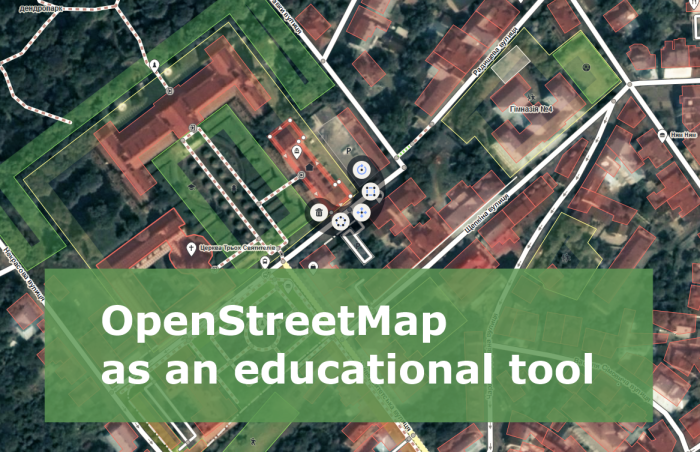
Висока вартість ліцензованого програмного забезпечення сьогодні є «непід’ємною» для більшості українських вишів. Вирішенням цієї проблеми є вискористання в навчальному процесі вільних ГІС програм, що поширюються безкоштовно.
Під час підготовки студентів у різноманітних галузях, пов’язаних із використанням природних ресурсів, дуже важливим є вивчення основ ГІС. Навчальні плани підготовки фахівців із самих різних спеціальностей включають сьогодні вивчення основ професійного використання ГІС.
Однак, українські виші на шляху надання студентам якісної освіти у сфері застосування ГІС стикаються із традиційною проблемою, що, на жаль, роками не втрачає актуальності: нестачею коштів. Вартість програмного геоінформаційного забезпечення з ліцензією на одного користувача сягає декількох тисяч доларів США. Так, наприклад, славнозвісна ArcGIS залежно від рівня комплектації коштуватиме від 4 000 до 20 000 американських доларів, а популярна зараз ГІС «Карта 2011» у професійній версії – приблизно 1 500 доларів. Зрозуміло, що такі суми не викликають оптимізму у викладачів та керівництва навчальних закладів і вимагають пошуку альтернативних варіантів.
Гарним вирішенням цієї проблеми можуть бути відкриті або «вільні» ГІС-програми, які можна використовувати протягом необмеженого терміну без обмежень у функціональності. Основні особливості відкритого програмного забезпечення включають вільне поширення, доступний початковий код та дозвіл на модифікацію цього вихідного коду. Безумовно, найпривабливішим параметром відкритого програмного забезпечення ГІС є відсутність плати за ліцензію.
Найбільш відомими прикладами відкритих ГІС є Quantum GIS, GRASS, gvSIG, SAGA та ін. Функціональні можливості цих програм мало в чому поступаються пропрієтарному програмному забезпеченню, багато з них мають зрозумілий українським користувачам україномовний чи російськомовний інтерфейс, що значно полегшує роботу з подібним ПЗ.
Відкрите програмне забезпечення для ГІС постійно вдосконалюється та розвивається. У світі є багатий успішний досвід практичного використання відкритого програмного забезпечення для освіти, науки та бізнесу. Лише на конференції “Відкриті ГІС”, що проходила 21-22 листопада в Москві, було представлено більше 40 доповідей щодо найрізноманітніших аспектів практичного використання вільних ГІС. Отже, можливостей, що надають вільні ГІС сьогодні, сповна достатньо для засвоєння студентами початкового рівня володіння інструментарієм ГІС.
Специфікою майбутньої професійної діяльності фахівців природничих спеціальностей є робота з картографічними матеріалами. Наразі повсюдно відбувається переведення традиційних паперових карт, які в багатьох галузях все ще залишаються основним носієм просторової інформації, у цифровий формат. Це обумовлює необхідність надання студентам навичок роботи з геоінформаційними системами як основним інструментом створення цифрових карт і роботи з ними.
Щоб правильного підібрати необхідний та достатній для забезпечення навчального процесу набір ГІС-програм треба уявити собі основні етапи створення цифрової карти. Для того, щоб створити цифрову карту використовують різні способи або їх комбінації. Найчастіше це:
оцифровка паперових картографічних матеріалів;
обробка результатів геодезичних зйомок
цифрова фотограмметрія;
векторизація растрових зображень.
Найбільш поширеною досі є процедура створення цифрової карти шляхом оцифрування звичайних паперових карт. Її основними етапами є:
сканування паперової карти;
обробка і редагування сканованого зображення;
векторизація растрового зображення;
формування цифрової карти як своєрідної інтерактивної бази даних з графічним інтерфейсом.
У ході роботи формується декілька проміжних картографічних продуктів, які мають різні моделі представлення даних у цифровій формі. Так, після сканування паперової карти ми отримуємо її растрове зображення, а після його векторизації – векторну модель карти. При подальшій роботі з цифровою картою може виникати необхідність її подальшого перетворення. Наприклад, для ефективного аналізу такого важливого фактору як рельєф території необхідно використовувати цифрові моделі рельєфу (ЦМР), для представлення яких найчастіше використовуються растрові або триангуляційні моделі даних.
Отже, для формування цифрової карти необхідно мати програмне ГІС-забезпечення, яке б дозволяло виконувати векторизацію растрових зображень, ефективно працювати як із векторними, так і з расторовими зображеннями, перетворюючи одне на одне, а також створювати бази геоданих. Крім того, в сучасній практичній діяльності, пов’язаній із використанням будь-яких просторово поширених природних ресурсів чи об’єктів, як-то ґрунти, ліси, водойми, населені пункти тощо все частіше використовують дані дистанційного зондування, які мають саме растрову форму.
Оптимальним, відповідно, є такий набір програм:
векторизатор, тобто програма, що дозволяє переводити скановані зображення у векторну форму;
геоінформаційна система, як програма, що, власне, й дозволяє формувати базу геоданих та працювати з нею;
системи обробки знімків (СОЗ), або як їх іноді називають «растрові» ГІС – програми, що дозволяють проводити аналіз растрових зображень.
На підставі власного досвіду та досвіду колег із викладання ГІС для студентів аграрних спеціальностей, а також геоекологів, рекомендуємо використовувати таку «зв’язку» ГІС-програм: Easy Trace Pro, QGIS, TNTmips.
Вказані програми мають відкриті версії та належну доступну документацію для користувачів.
Пакет EasyTracePro дозволяє швидко і якісно векторизувати найрізноманітніші картографічні матеріали. Це цілий арсенал утиліт та інструментів націлений як на отримання даних з растрів, так і на корекцію вже існуючих векторних даних (рис.1).
Рисунок 1. Робоче вікно програми EasyTracePro – відбувається автоматична векторизація топокарти
Векторизація може проводитись як у ручному, так і в автоматичному режимі. У програмі закладені різноманітні сценарії щодо виконання процедури векторизації, які дозволяють значно прискорити процес та підвищити його якість. Використання правил топології дозволяє проводити перевірку векторизованих даних та автоматично знаходити помилки. Програма підтримує експорт та імпорт найбільш розповсюджених ГІС-форматів (ArcINFO, ArcView, AutoCAD, Credo, MapInfo, MicroStation). Версія програми EasyTracev7.99 ProFREE – надається безкоштовно й може вільно використовуватись у навчальному процесі.
QGIS – це відкрита геоінформаційні система, яка розповсюджується під ліцензією GNU General Public License. Основним призначенням системи є обробка й аналіз просторових даних та підготовка різної картографічної продукції. Програма за своєю функціональністю мало чим поступається відомим пропрієтарним ГІС. Пакет має гнучку систему розширень, які можна створювати на мовах С++ і Python. Підтримуються різноманітні векторні і растрові формати, включаючи ESRI Shapefile і GeoTIFF. У даний час QGIS є однією з найбільш функціональних і зручних настільних геоінформаційних систем, яка динамічно розвивається.
Основним призначенням продукту TNTmips є обробка растрового зображення (рис. 2).
Рисунок 2. Прив’язування космічного знімка в програмі TNTmips – одне із завдань для практичних занять
Проте зважаючи на постійні оновлення свого функціоналу та розширення спектру діяльності, дана система придатна для використання в широкому колі додатків:
аналіз, обробка, автоматизоване дешифрування матеріалів дистанційного зондування;
географічні інформаційні системи;
цифрова картографія;
фотограмметрична обробка зображень;
складання, редагування та видання карт;
геофізичні та геологічні додатки;
засоби автоматизації обліку земель та побудови банків даних із землекористування ;
засоби для зберігання, збору, візуалізації та аналізу різноманітної картографічної інформації;
створення електронних атласів і довідників у різних галузях виробництва, науки та освіти.
Завдяки постійному розвитку і гнучкості системи коло додатків не обмежується перерахованим.
У навчальному процесі зазначені програмні продукти використовуються в комплексі. Це дозволяє якісно виконати поставлене перед студентом завдання, оцінити точність виконання окремих його складових та, в той же час, вивчити основні можливості одразу декількох пакетів програмного забезпечення. Зважаючи на доступність зазначених програмних продуктів, стає можливим і самостійна робота студента не лише у спеціалізованому комп’ютерному класі, до якого раніше його «прив’язували» ліцензійні ГІС, а і вдома, що значно покращує як основні навички студентів, так і їх успішність.







“…а популярна зараз ГІС «Карта 2011» у професійній версії – приблизно 1 500 доларів. Зрозуміло, що такі суми не викликають оптимізму у викладачів та керівництва навчальних закладів і вимагають пошуку альтернативних варіантів.” – хотелось бы, чтобы перед тем как опубликовывать информацию, автор ее бы проверял. Для ВНЗ (обучения) – цены = 10% от базовых, при полном функционале
Уважаемый Виталий! Благодарим Вас за внимание к нашему блогу. При подготовке поста мы использовали открытые данные об актуальных на тот момент ценах, опубликованные на сайте ГИС Панорама. Сведения о 90% скидке для ВУЗов в официальном прайсе не содержатся. 10% процентов стоимости, конечно, существенно уменьшает проблему и такая “гуманная” политика производителей по отношению к ВУЗам не может не радовать. Однако это не отменяет того факта, что абсолютное большинство лицензионных ГИС в украинских ВУЗах приобретены в результате грантовой поддержки по тем или иным образовательным программам. И в условиях перманентного финансового кризиса высшей школы свободные ГИС дают возможность большей свободы выбора, а в ряде случаев, являются панацеей.